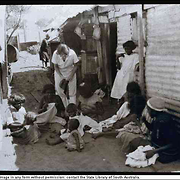
Women washing clothes, c. 1930, by Hyde, Ruby, courtesy of State Library of South Australia.
Details
The Ooldea Mission was established by the United Aborigines Mission (UAM) in 1933 at Ooldea Soak. A government Aboriginal reserve was established in 1938 that encompassed the Mission. A children's dormitory was established at the Mission which accommodated up to 60 Aboriginal children. A small number of children were moved to Gerard Mission in 1945. In 1952 the Mission and the Dormitory closed down. All residents were moved to the government reserve and Lutheran Mission at Yalata.
In 1933, missionary Annie Lock arrived at Ooldea Soak with her companion, Miss Marshall. Together they set up the Ooldea Mission, four miles from the Ooldea railway siding. In 1938 two thousand square miles (5200km) of country surrounding Ooldea Soak was made a government reserve. From this time the mission, run by the United Aborigines Mission (UAM), rapidly developed. A Children's Dormitory was built consisting of two sections, one for boys and one for girls. By 1944, 44 children were living in the Dormitory. That year additions were made to the Mission including a new dormitory for girls, a dining room, a kitchen and a hospital.
In the mid to late 1940s several young married couples had been sent from Ooldea to the new Gerard Mission near Loxton. A small number of children were also transferred to the dormitory at Gerard.
In 1951, when Professor JB Cleland of the University of Adelaide's Board for Anthropological Research visited the area, 31 boys and 24 girls were accommodated in the dormitories. His report included the following description:
The Boys' Dormitory is old but clean. The boys sleep on the floor, several together for warmth in cold weather, with two blankets covering several boys. There is a receptacle for urine in the middle of the room. The children have meals in this same room after it has been swept and cleaned in the morning. The girls' dormitory is a very nice room, with plenty of ventilation by louvre glass windows. There was no smell. It is very clean. The beds were nicely made. Most of the girls sleep on wire beds with two blankets (little enough in winter weather) one girl to a bed. 3 sleep on the floor (the floor would probably be warmer in winter). Several girls and boys wet their beds at night…The children doing this may be deprived sometimes of cake, but are not otherwise punished.
Cleland also reported that the children in the dormitories received 'three good meals a day as well as clothing and housing'. He stated that Mr Harrie Green, the Mission Superintendent, produced regular returns to his head office which listed the names of all the children living in the dormitories and noted admissions and discharges.
By 1951 the state of the Mission was poor. Buildings were riddled with white ants and the rainwater tanks were corroded. Plans were underway to close the Mission and move the population to make way for the Long Range Weapons Organisation program being run out of Woomera, and the British nuclear testing at Maralinga, north of Ooldea. The government had purchased land for a new Aboriginal reserve at Yalata 130 miles east of Ceduna on the west coast of South Australia.
In 1952, an internal dispute within the UAM led to a split between the Federal body which was based in Victoria and the South Australian Council. This schism resulted in the early closure of the Ooldea Mission because all of the staff, loyal to the Federal body, moved out. Lutheran missionaries from the Koonibba Mission were sent to Ooldea to assist. They helped to move everyone, including children from the Dormitory, to the government reserve at Yalata. Two years later the Lutheran Missionaries established the Yalata Mission on the reserve.
In 2021, the South Australian government has agreed to be a funder of last resort for this institution. This means that although the institution is now defunct, it is participating in the National Redress Scheme, and the government has agreed to pay the institution's share of costs of providing redress to a person (as long as the government is found to be equally responsible for the abuse a person experienced).
Sources used to compile this entry: George, Karen, Finding your own way, Nunkuwarrin Yunti of South Australia Inc., 2005, http://nunku.org.au/resources/; Hampton, Ken and Christobel Mattingley, Survival in our own land: 'Aboriginal' experiences in 'South Australia' since 1836, Wakefield Press, Adelaide, 1988.
Prepared by: Karen George and Gary George
Created: 15 February 2011, Last modified: 7 December 2021